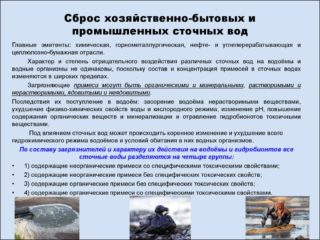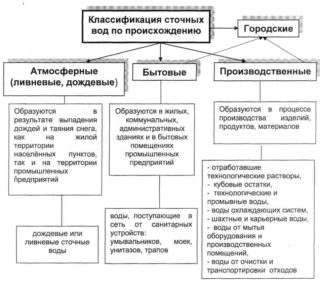Chemical analysis of effluents is required by the owners of industrial enterprises. It is also necessary for the owners of personal plots if there is a septic device with a salvo discharge function. Untreated liquid can pollute the environment.
The purpose of the study of sewage
The need for expertise may appear:
- when carrying out production control;
- when creating an information base for the subsequent drafting of regulatory documents;
- regularly in organizations dealing with wastewater treatment.
If violations are found, an emergency check is possible.
Wastewater is also subjected to expert testing at the request of the owners in order to assess the situation after detecting cases of violation of sanitary rules and regulations. In such situations, studies are carried out simultaneously in several directions, taking into account the discharge method that is used at the facility.
Classification and degree of pollution
Household wastewater contains all liquid substances that are sent to the sewer system from plumbing fixtures in apartments and private houses connected to a centralized network. In the pipeline, the drains form a homogeneous fecal mass. The concentration of hazardous impurities in it depends on the volume of water used by one person.
The level of pollution in domestic wastewater is determined by the following parameters:
- biological - the presence of protozoa, fungus, mold;
- mineral - the presence of salt and sandy suspensions, alkaline and acidic compounds;
- organic - detection of animal and plant fractions.
Wastewater from industrial complexes is extremely dangerous, as it can contain radioactive waste and toxic chemicals. The most stringent requirements are applied to such fluids, and the owners of production facilities must provide preliminary treatment of effluents before they enter the citywide network in order to avoid an environmental catastrophe or an epidemic of infectious diseases.
The specifics of the examination
They examine sewage fluids in laboratory conditions at the industrial facility itself or in a sanitary and epidemiological station. The cost of conducting high-quality chemical analyzes of wastewater in different laboratories depends on the extent to which testing should take place. The average price of a full comprehensive study for industry organizations is about 16,000 rubles. For private needs, a sample analysis costing 3,500 rubles is sufficient.
Expertise is always carried out according to the standard scheme:
- They order a service, call specialists.
- They go to the site to collect samples.
- Samples are taken for examination and an official act is drawn up.
- Laboratory analysis is performed.
If violations are found, a resolution is issued with a list of recommendations for their elimination.
In an unscheduled inspection, the responsibility for collecting samples lies with the owner of the sewerage facility. To do this, perform the following actions:
- Find a clean jar or bottle made of plastic or glass with a volume of at least a liter. Rinse thoroughly with running water. The container must be equipped with a sealed lid. Such a container can be taken from the laboratory, where they will be tested.
- Before collecting a sample of liquid, rinse the container with this water.
- The container is filled almost to the top, leaving a small gap between the water level and the lid. Sampling is carried out at the very exit of the sewer pipeline.
Samples must be brought to the laboratory no later than two hours later. At the same time, try to keep the sample in a cool, dark place during transportation.
If an increased degree of contamination is detected, a secondary study will be required after the violations are eliminated.
Key research indicators
- Chemical - the balance of acids and alkalis. The liquid is checked against a basic pH reaction. At a permissible concentration of polluting chemicals in wastewater, pH values are from 6.5 to 8.
- Biological - the concentration of intestinal bacteria, viruses and fungi.
- The value of dry and total residue. The first is checked for a crude sample, the second for a liquid that has passed through the filter. A maximum total residue of more than 10 g / l is not allowed.
- Measurement of the level of oxidation according to the data of biochemical oxygen demand (BOD). The number of aerobic microorganisms using organic impurities as substrates for their vital activity is estimated.
- The content of phosphorus and nitrogenous compounds. They indicate the presence of nitrites, nitrates and ammonium nitrogen, which contribute to the biological purification of sewage effluents.
- The presence of surface-synthetic active substances. Residual content indicates that the oxygen in the drain fluid is normal.
- The presence of organic and inorganic toxins. Toxicity is expressed in units of LD50 with tolerable values depending on the specific substance.
Qualitative analysis of effluents involves physical methods for determining pollution - color, transparency, odor, temperature. Each aspect is assessed visually.
Also, the contaminated liquid is checked for the presence of sulfates and chlorides, traces of oily products, radioactive substances.
The list can be increased taking into account the aspects of the enterprise, the number of existing risks of contamination or insufficient treatment of effluents.
To determine the composition of wastewater in an autonomous sewage system, criteria such as transparency, acid-base balance, the presence of suspended impurities and bio-pollutants, and the concentration of dissolved oxygen are usually examined.
Express analysis
If testing in the laboratory is not possible, it is possible to determine the approximate composition of the effluent in the field. The procedure will require a minimum of equipment and time.
Physical criteria of liquid, colorimetric readings are analyzed.
A photocolorimeter or standard solution and coloring chemicals are used to examine the latest data. The acid-base balance, the presence of surfactants, chlorine, heavy metal salts, and the concentration of soluble oxygen are determined. If the indicators are exceeded, a more accurate laboratory analysis will be required.
If the pollution of wastewater is off scale, the installation of treatment facilities is required. Their choice is conditioned by the possibility of a positive influence on the indicators that are exceeded in the chemical research.











